
This collection of articles and media are for those who want administrative level training on Cisco Spark.
- Subject:
- Computer Science
- Material Type:
- Module
- Author:
- Donald Michael Jr.
- Date Added:
- 02/26/2018

This collection of articles and media are for those who want administrative level training on Cisco Spark.
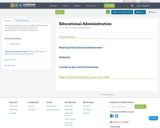
Educational Administration is a subject which helps us in studing and understanding the traits of administration of educational institutions.
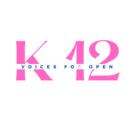
The Educator & Staff Professional Learning Plan is one component of the K-12 Voices for Open OER - DEIA Action Planning Guide. This plan, and the entire guide, is intended as a strategic planning tool for district leaders wishing to promote the already pedagogically and financially compelling practice of creating or adapting open educational resources (OER) to help achieve district goals in serving all students through diversity, equity, inclusion, or accessibility (DEIA) lens. The guide provides step-by-step planning tools, including examples, templates, and resources to help district leaders articulate and establish action plans for what we refer to as "OER-DEIA." The entire guide is an open educational resource itself, free and openly licensed for reuse, remixing, and resharing.

This guide is the fourth and final guide in the series and focuses on evaluating the processes and outcomes in the strategic plan.
Evaluation is central to strategic planning as it allows you to review what is and isn’t working on the school improvement journey. There are 2 types of evaluation you should consider:
Process evaluation examines whether practices have been applied in the way they were planned.
Outcome evaluation examines whether practices are having the desired effect on student learning.
Process and outcome evaluation both play key roles at different stages of a strategic plan’s life cycle.
This guide recommends practical steps for evaluating processes for improving practices, as well as the effect of these practices on student learning. We recommend reading this guide after you have read the third guide in this series, Selecting Practices to Deliver Improvement.

This book is written for those interested in acquiring a thorough knowledge base relative to the intricacies of the organizational theories, customs, and insights significant to the management of health service organizations. It examines the foundational aspects of leadership and management as they relate to establishing and maintaining the principles and practices within healthcare organizations. The book opens with a discussion on the differences between health, healthcare, and health care while providing an overview of healthcare management and organizational trends. It culminates in discussions of leadership, management, motivation, organizational behavior, and management thinking. Additionally, it discusses topics of information technology, teamwork, health disparities, organizational culture, performance, and change.

On April 18, 2023, #GoOpen held a public webinar titled, "Integrating OER into Instructional Initiatives." The session featured Rebecca Henderson, Curriculum Services Supervisor, Westmoreland Intermediate Unit, PA; Tracy Rains, Virtual Learning Specialist, Appalachia Intermediate Unit 8, PA; and, Kelly Hammond, OER and Open Pedagogy Adjunct, CUNY School of Professional Studies; and facilitator, Amee Evans Godwin of ISKME and the #GoOpen National Network.

PowerPoint presentation from the January 2022 School Medicaid Office Hours.
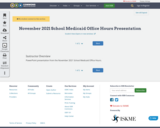
PowerPoint presentation from the November 2021 School Medicaid Office Hours.

This guide is intended as a strategic planning tool for district leaders wishing to promote the already pedagogically and financially compelling practice of creating or adapting open educational resources (OER) to help achieve district goals in serving all students through diversity, equity, inclusion, or accessibility (DEIA) lens. The guide provides step-by-step planning tools, including examples, templates, and resources to help district leaders articulate and establish action plans for what we refer to as "OER-DEIA." The entire guide is an open educational resource itself, free and openly licensed for reuse, remixing, and resharing.

The links within this resource are designed to provide educators with background context regarding the development of the K-12 Voices for Open OER-DEIA Action Plan for K-12 District Implementation. Presented as a poster session at the 2022 OpenEd Conference, the slides explain the purpose of the Guide, as well as the development process.This guide is intendend as a strategic planning tool for district leaders wishing to promote the already pedagogically and financially compelling practice of creating or adapting open educational resources (OER) to help achieve district goals in serving all students through diversity, equity, inclusion, or accessibility (DEIA) lens. The guide provides step-by-step planning tools, including examples, templates, and resources to help district leaders articulate and establish action plans for what we refer to as "OER-DEIA." The entire guide is an open educational resource itself, free and openly licensed for reuse, remixing, and resharing.

This poster helps to explain the development process of the OER-DEIA Guide developed by K-12 Voices for Open, which can also be found on OER Commons.
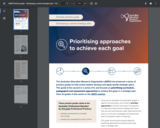
This guide is the second in a series of 4, and focuses on prioritising curriculum, pedagogical and assessment approaches to achieve the goals in a strategic plan. Once you’ve set goals and associated targets in specific learning areas, you’ll need to prioritise approaches to achieve each goal. An approach is a high-level improvement strategy that shows how you will work towards a goal. Approaches that focus on curriculum, pedagogy and assessment have the greatest impact on learning. This guide recommends practical steps for prioritising approaches to achieve each goal within a strategic plan. We recommend reading this guide after you have read the first guide in this series, Setting Goals and Targets for Student Learning. After reading this guide, we recommend you read Selecting Practices to Deliver Improvement.
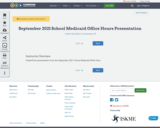
PowerPoint presentation from the September 2021 School Medicaid Office Hour.
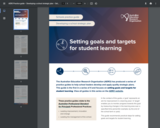
Strategic planning is an iterative process that requires a purposeful investment of time. These guides are designed for flexible use alongside system supports, providing a starting point rather than a complete outline of everything schools must do. They are designed to help school leaders with strategic planning directly related to learning. School leaders may also choose to include aspects of school improvement that enable learning (for example, student wellbeing) using a similar approach. Some guidance may not apply in all contexts and may look different in schools of different sizes. Reasonable adjustments should be made to fit school context where necessary. This guide is the first in a series of 4 and focuses on setting goals and targets for student learning. In the context of this guide, a 'goal’ represents an aim for improvement in a learning area. A ‘target’ enables you to monitor progress towards this goal by measuring changes in the learning area over a specified time period (for example, by the end of the school term or year). This guide recommends practical steps for setting goals and targets for student learning. After reading this guide, we recommend you read Prioritising Approaches to Achieve Each Goal.
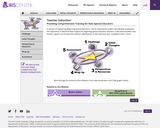
A revision of Supporting Beginning Special Educators: Tips for Educational Leaders, this Module emphasizes the importance of administrative support for beginning special education teachers. It also demonstrates how teacher support can increase the teacher's effectiveness in the classroom (est. completion time: 1 hour).

This template is part of the K-12 Voices for Open OER-DEIA Action Plan for K-12 District Implementation. The template, and the entire guide, is intendend as a strategic planning tool for district leaders wishing to promote the already pedagogically and financially compelling practice of creating or adapting open educational resources (OER) to help achieve district goals in serving all students through diversity, equity, inclusion, or accessibility (DEIA) lens. The guide provides step-by-step planning tools, including examples, templates, and resources to help district leaders articulate and establish action plans for what we refer to as "OER-DEIA." The entire guide is an open educational resource itself, free and openly licensed for reuse, remixing, and resharing.

This template is part of the K-12 Voices for Open OER-DEIA Action Plan for K-12 District Implementation. The template, and the entire guide, is intendend as a strategic planning tool for district leaders wishing to promote the already pedagogically and financially compelling practice of creating or adapting open educational resources (OER) to help achieve district goals in serving all students through diversity, equity, inclusion, or accessibility (DEIA) lens. The guide provides step-by-step planning tools, including examples, templates, and resources to help district leaders articulate and establish action plans for what we refer to as "OER-DEIA." The entire guide is an open educational resource itself, free and openly licensed for reuse, remixing, and resharing.

This template is part of the K-12 Voices for Open OER-DEIA Action Plan for K-12 District Implementation. The template, and the entire guide, is intendend as a strategic planning tool for district leaders wishing to promote the already pedagogically and financially compelling practice of creating or adapting open educational resources (OER) to help achieve district goals in serving all students through diversity, equity, inclusion, or accessibility (DEIA) lens. The guide provides step-by-step planning tools, including examples, templates, and resources to help district leaders articulate and establish action plans for what we refer to as "OER-DEIA." The entire guide is an open educational resource itself, free and openly licensed for reuse, remixing, and resharing.

This course discusses management methods of relevance to public transportation systems. Topics include strategic planning management, labor relations, maintenance planning and administration, financing, marketing and fare policy, and management information and decision support systems. The course shows how these general management tasks are dealt with in the transit industry and presents alternative strategies. It also identifies alternative arrangements for service provision, including different ways of involving the private sector in public transportation.

This class surveys the current concepts, theories, and issues in strategic management of transportation organizations. It provides transportation logistics and engineering systems students with an overview of the operating context, leadership challenges, strategies, and management tools that are used in today’s public and private transportation organizations. The following concepts, tools, and issues are presented in both public and private sector cases: alternative models of decision-making, strategic planning (e.g., use of SWOT analysis and scenario development), stakeholder valuation and analysis, government-based regulation and cooperation within the transportation enterprise, disaster communications, systems safety, change management, and the impact of globalization.